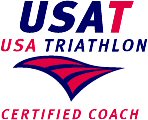Cross Training for Runners
By USA Triathlon Coach Ken Johnson
Want to run better? Try not running one or two times a week. But don't sit on the couch. Instead, cross train.
Many runners have discovered the advantages for cross training, and many training plans include an "XT" (for cross training) one or two days a week. Cross training is simply a non-running aerobic workout that is substituted for one of your running workouts. This other activity supports your running program and your overall running goals.
What are the benefits of cross training for runners?
- You give your running muscles a little rest. In cross training you are using different muscles or using the same muscles in a different way. There is less chance of running over-use injuries, and you'll increase overall muscle strength.
- If you are injured from running, cross training allows you to maintain fitness by exercising without causing additional damage to your body - particularly pounding of the legs.
- You can add intensity to your training schedule. While you might not want to do more than one long run per week, it's not difficult to add one long bike ride without impacting on your running. Since things like cycling and swimming are non-impact, you can go hard in your cross training workout with less chance of injury.
- Cross training on the day after a hard or long run will help wash the lactic acid out of your muscles, and get rid of stiffness. Without subjecting your legs to more pounding.
- It's a way to maintain your fitness in the winter months, particularly if cold and bad weather keep you inside and you just can't face the treadmill.
- It add variety to your training. Just running, particularly on the some route, can quickly get boring. Cross training offers a different experience.
Some cross training exercises:
- Pool Running - Probably the most recommended activity for the injured runner, water running simulates running on land, but with no impact. Use a flotation belt or vest so that your feet are off the bottom. Use the same motion as running on land, and concentrate on keeping your body straight in the water. The pressure and density of the water will improve your form because you can "feel" improper movements. The water also gives your upper body a workout that you don't get on land.
- Cycling - Riding a bike outdoors, or inside on stationary bike or bike trainer, helps develop your quadriceps. This can balance out the strengthening of your hamstrings and calves from running. It will also increase hip and knee joint flexibility. Cycling can also help build your cardiopulmonary system without stress on your joints from hitting the ground. Higher isn't necessarily better: Don't "grind" in the upper gears. A better strategy is to work on quick pedaling, at a cadence of 80-90 pedal revolutions per minute. You'll be most comfortable in padded bike shorts or tights; if you ride outside, always wear a helmet.
- Elliptical Fitness Machines - These machines are increasingly popular in heath clubs, combining running, cross country skiing, and stair climbing. You can easily duplicate your running workout in both time and intensity.
- Stair Climbing - Stair climbing machines will help build the strength for running hills. Try to simulate your natural running form as much as possible, but keep your feet flat on the step so you don't strain your Achilles tendons. Try to use the machine without holding onto the hand rails, or hold them lightly. It's better to use a stair machine rather than walking up actual stairs, because it's minimal impact.
- Swimming - Many cross training athletes, those called triathletes, know swimming is an excellent no-impact way to improve your overall fitness. It will build muscles in your upper body while taking much of the stress off the legs. It stretches the hamstrings and increases ankle flexibility. Swimming is, however, much more of a skill sport than running, so you may want to consider taking a swim class, clinic, or working with a swim coach when starting out.
If you run and train with a heart rate monitor, you can continue to use it while cross training. However, since cycling and swimming are non weight-baring, and since water in the pool with both supports your body and cool you, you will need to adjust your heart rate training zones. For biking, subtract about 10 beats per second; for swimming and pool running, subtract 15.
Whatever cross training exercise you choose, start slow. Just because you can run for an hour doesn't necessarily mean you can ride a mountain bike through the hills for an hour. Gage your endurance and fatigue, and don't go beyond your limits just because it's not running. Cross training shouldn't cross you over into overtraining.
3-Fitness Triathlon Training Coach Ken's Triathlon Training at the RecPlex








